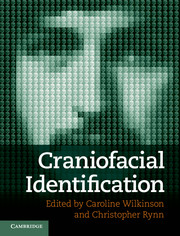Book contents
- Frontmatter
- Contents
- Contributors
- Part I Identification of the Living
- Part II Identification of the Dead
- Chapter 14 Post-mortem prediction of facial appearance
- Chapter 15 Manual forensic facial reconstruction
- Chapter 16 Relationships between the skull and face
- Chapter 17 Automated facial reconstruction
- Chapter 18 Computer-generated facial depiction
- Chapter 19 Craniofacial superimposition
- Chapter 20 Juvenile facial reconstruction
- Index
- Plate Section
- References
Chapter 15 - Manual forensic facial reconstruction
Published online by Cambridge University Press: 05 May 2012
- Frontmatter
- Contents
- Contributors
- Part I Identification of the Living
- Part II Identification of the Dead
- Chapter 14 Post-mortem prediction of facial appearance
- Chapter 15 Manual forensic facial reconstruction
- Chapter 16 Relationships between the skull and face
- Chapter 17 Automated facial reconstruction
- Chapter 18 Computer-generated facial depiction
- Chapter 19 Craniofacial superimposition
- Chapter 20 Juvenile facial reconstruction
- Index
- Plate Section
- References
Summary
Introduction
Manual forensic facial reconstruction is one of the most subjective, as well as one of the most controversial techniques in the field of forensic anthropology. Nevertheless, the process has had enough successful results to allow the advancement of research and methodologies. That there exists an interrelationship between the skull and face is unquestionable, but the precise nature of this relationship is complex, variable and not yet fully understood.
Controversy
Although there are several scientific branches involved, critics have said that the technique is subjective and controversial due to the presence of an artistic aspect (Stadtmuller, 1922; Suk, 1935; Stephan, 2003). It could be argued that manual reconstruction depends on the expertise of the practitioner, or even on what inspires him or her that particular day!
There have been various studies where reconstructions from several practitioners were compared, which did not suggest high reliability or reproducibility (Stadtmuller, 1922; Haglund and Reay, 1991; Helmer et al., 1993; Bongartz et al., 2005). Unfortunately these studies did not account for different levels of artistic/sculptural expertise or knowledge and experience in facial anatomy/anthropology, with novices/students compared with established experts. Often even the methods of facial reconstruction varied between practitioners.
Throughout the years, the manual technique has often provided spectacular results in seemingly hopeless cases, yet a large part of the scientific community remains sceptical (Suk, 1935; Stephan, 2003). This chapter aims to demonstrate that artistic input is essential when utilising the manual technique, and how the subjective aspect can be minimised.
- Type
- Chapter
- Information
- Craniofacial Identification , pp. 184 - 192Publisher: Cambridge University PressPrint publication year: 2012
References
- 1
- Cited by



